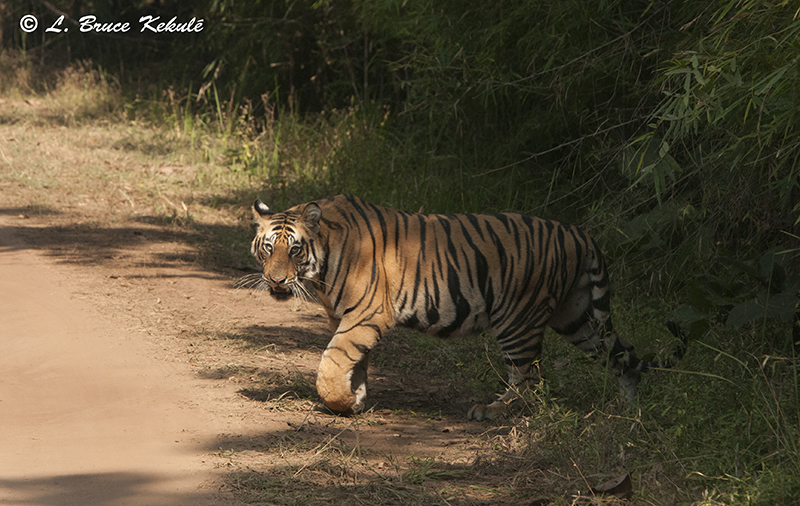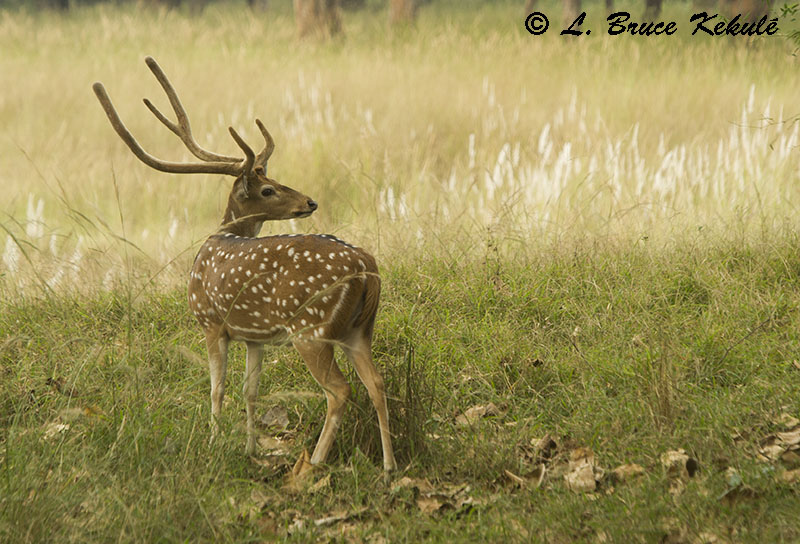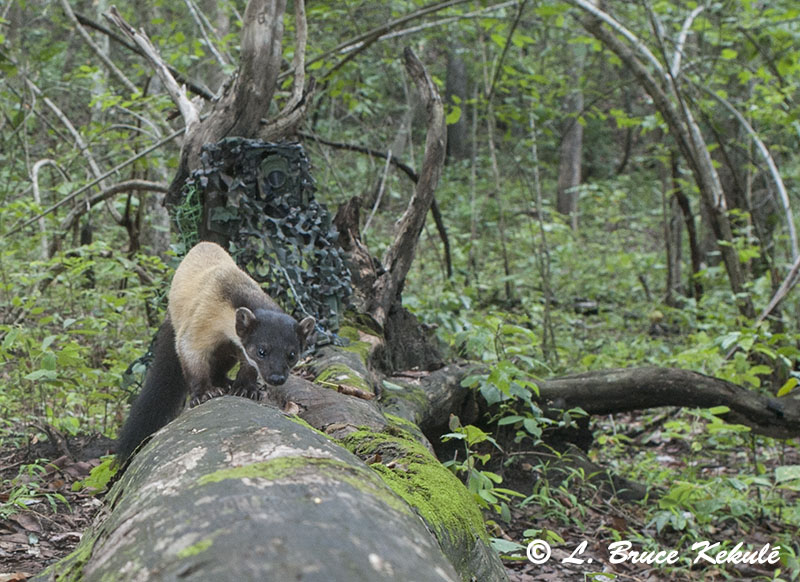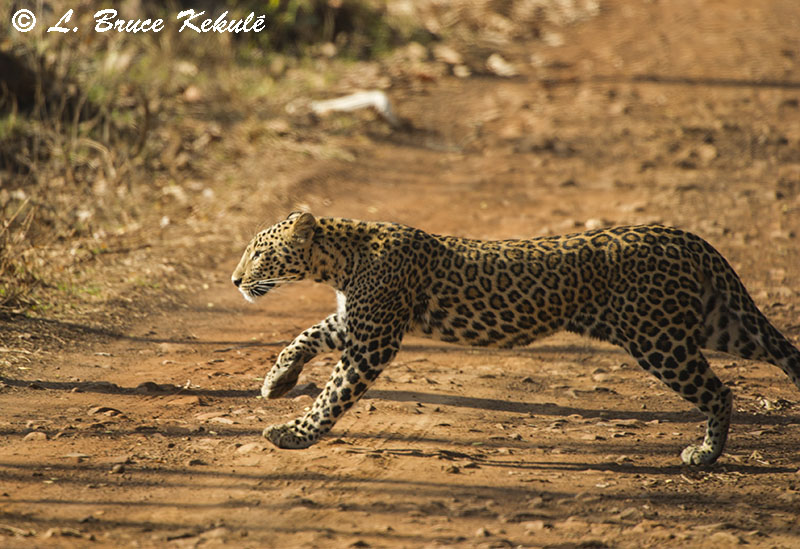Posts Tagged ‘predator’
Nikon D700 catches an Indochinese tiger
A female tiger returns again…!
About five months ago, I set a Nikon D700 DSLR camera trap at a hot spring deep in the interior of the Western Forest Complex of Thailand. I managed to get some nice shots of a female Indochinese tiger as she walked back and forth, and up and down to the mineral seep. I then moved the D700 to another tree close by for a better capture and composition. When I got to my camera last week and checked my files on the Nikon, I almost fell off the log I was sitting on. There she was again but this time with expression, behavior, focus and exposure perfect. This shot is one of my best all time tiger camera trap images….great success at last at this new location…Enjoy…!
Camera: Nikon D700 full-frame body
Lens: Nikon 35mm manual lens (very old)
Sensor: Snap Shot Sniper SSII
Case: Pelican 1150
Box: Aluminum ‘elephant proof’ housings for camera, flashes and sensor
Flashes: Two Nikon SB-28s
Exposure: 1/200th – ƒ5.6 – ISO 400
The first shot in the string…!
An Indochinese tiger caught by a Canon 600D: my favorite tiger image..!
After a few years of DSLR camera trapping in the Western Forest Complex of Thailand, I have finally chosen an image of a male Indochinese tiger caught one afternoon at 4.41pm that is my all-time favorite. For this location, I built a Canon 600D with an old Nikon 50mm manual lens incorporating an adapter (Nikon to Canon) in a Pelican 1150 case with an external Snapshotsniper SS II sensor on a 10-meter hardwire, and two SB28s in Tupperware® style boxes also on 10-meter hardwires. This mature tiger was out hunting when he passed the cam and the manual settings were ISO 400; ƒ8; 1/100 sec. and this shot was the last in a string of six. Enjoy…!
Nile crocodiles and a genet in Kenya
In late December of 2012, I did my last safari to Samburu National Park in Northern Kenya. At the lodge I was staying at, big Nile crocodiles would come up at night into the hotel grounds next to the river (closed-off to people of course) and set-up one of my Sony S600 home-brews on the fence. It was more or less a tourist attraction as the staff fed the crocodiles with left-overs. That night, a slew of them came-up out of the river and the old 600 did its job. One frame shows a genet (little carnivore) caught taunting the crocs…it was one on those weird moments in nature where the little guy must have known it could out-run the fat reptiles…..Enjoy…!
The Forests of Madhya Pradesh in India – Part Two
Kanha National Park and Tiger Reserve
A young female leopard in early morning in Kanha National Park and Tiger Reserve.
The next stop on my 20-day tiger safari through November 2015 to India was Kanha National Park and Tiger Reserve situated several hundred kilometers southwest of Bandhavgarh. I left the King’s Lodge in a nice air-conditioned taxi around noon and arrived at the Kanha Earth Lodge outside the park in the late afternoon. This was to be my home for the next four-nights and it was very pleasant with the bungalows built mainly from natural materials.
Kanha is quite famous for its tigers and other creatures like leopard and sloth bear. Prey species such as gaur and spotted deer (chital) also thrive in great numbers and play an important role as a food source for the big cats. The lush Sal and bamboo forests, grassy meadows and ravines of Kanha provided inspiration to Rudyard Kipling’s famous novel ‘Jungle Book’ and it lives up to its name as one of India’s best tiger reserves. However, it is a bit over-visited at the moment with hundreds of tourists visiting almost daily which has had an effect on the balance of nature.
A mature female tiger named ‘Bandri Chapar’ seen above a waterhole in Kanha National Park and Tiger Reserve.
That night before dinner, I met my naturalist ‘Mr Happy’ as he likes to be called. I mentioned the fact that being happy was the secret to my success as a wildlife photographer and that I wanted to visit the nearest banyan tree on the way into the park. He said he knew where one was just inside the gate and that we could stop the next morning.
That night after a few whiskey sun downers, I slept like a log after the hectic trip along narrow roads and near misses that day. It was early to bed and early to rise at 4am. After a quick coffee, we headed to the front gate and when we got there, were greeted by hundreds of people and scores of jeeps and cantors (buses) wanting to get in. It was a madhouse but I tried to just ignore it and hoped that once we got in, things would thin out which they did. We picked up a forest guide that is required by the forest department and he jumped in the back seat.
Here she is marking her territory spraying urine on a tree next to the waterhole.
About 100-meters from the gate, Mr. Happy stopped at the banyan tree but park regulations do not allow one to get out of the jeep. I just made a silent prayer for good luck and then we motored in. A short time later (about 15 minutes), it was still a bit dark as we traveled deeper and then the guide called out that a leopard had just jumped across the road. Mr. Happy reversed slightly and there stood a young female looking at us from about 10 meters away. I quickly snapped off a few shots and was able to get one good image of the young cat. Her pupils were dilated, as morning light was just filtering in.
Now this was some seriously good luck for Kanha where leopards are extremely difficult to see and photograph. My spirits jumped a thousand percent. Later that morning, we saw a sloth bear but it was out of range and it slipped into the thick forest. Then it went quiet for the next couple of days with hardly any tiger sightings around the whole park. Then on day-three as we were motoring along some man-made ponds, my guide spotted a female tiger named ‘Bandri Chapar’ walking parallel to the road and calling out for a mate with that unmistakable call of a female in heat. “raaaawr, raaaawr, raaaawr”…! We were the only jeep around and we just reversed following her, and I did not stop shooting my camera.
After crossing the road in front of us, ‘Bandri Chapar’ looked at me one more time.
After several hundred meters, she came up close to our jeep and crossed the road in front of us. She then stopped on my left side looking straight at me, and then slipped into the bush as other jeeps began to show up. Again, the spirits from the banyan tree had granted my wish with some seriously good luck as many people had not seen a tiger and it was becoming sad to see so many long faces as hardly anyone had seen the striped predator. I of course was beaming that I had photographed her. It doesn’t get any better than that..!
I also saw barasingha deer (hard ground swamp deer) and got some good shots. The species almost went extinct here but the forest department started a breeding program saving the species just in time. There are over 600 now living in the park. The magnificent bovine species guar, also thrive here and I got some good shots of two large bulls just a mere twenty meters away.
Barasingha stags and doe plus spotted deer at the back in the grasslands.
It was a great five days and I would like to thank all my friends at the Kanha Earth Lodge, Pugdundee Safaris and the Forest Department in Kanha.
Next stop: Pench National Park and Tiger Reserve
The Forests of Madhya Pradesh in India – Part One
A Safari to Four National Parks and Tiger Reserves
‘Ghost of the Darkness’…a leopard crossing the main road in Bandhavgarh on Dewali Day, Nov. 11th, 2015.
The short flight of only three and half hours from Bangkok to New Delhi is just about right for me in this day and age of long distance traveling. I had organized another safari to India from November 8-28th in order to fill my galleries of wildlife photos from there. This was my forth trip to the sub-continent and was on my way to the State of Madhya Pradesh in the central region. Four different protected areas or tiger reserves as they are called there were chosen for this jaunt.
The first afternoon was spent in Delhi to stock up on some snacks like raisins, nuts and dark chocolate, and to work on getting my kit together for the up-coming trips into the forest. I took my Nikon D3s and a Nikon 200-400 VRII prime lens plus a D300s with a 70-200 VRII as my second along with several other short lenses and equipment which included a Nikon D3000 camera trap and external flashes and sensor. It was early to bed for the next morning’s 2-hour flight to Jabalpur further south. Then it was a 3-hour taxi ride east to my first location on a 20-day trip. The King’s Lodge in Bandhavgarh would be my home for the next four days.
Sub-adult male from a tiger named Shukhi Patiya coming out of hiding.
Bandhavgarh National Park and Tiger Reserve is quite famous have been covered by National Geographic years ago when Michael “Nick” Nichols photographed tigers in the park. He also used camera traps and got some amazing images of the big cats over a year that were published in the magazine. BBC has also done several documentaries on tigers here. It is well visited by foreign and local tourists wanting to see these amazing carnivores up-close. However, they are not that easy to spot anymore in the dense forest found here and lot’s of luck is needed too.
There are three zones (1-2-3) that are allocated when the on-line bookings are made. My first three days in Zone One with morning and afternoon safaris turned up empty handed. The festival of Dewali (Festival of Light) was going on and the park was closed on the 11th Nov so I opted for a safari in the ‘buffer zone’ but again flipped out. On our way back to the lodge however, a leopard jumped in front of the jeep and I managed one abstract shot of the fast cat crossing the road. Luck was about to change for the better.
A tigress named ‘Dottie’ on the road in the afternoon and she was my second tiger that day.
The next morning, I was slated to go into Zone Two. This was my last day and I began to have my doubts that I would get a tiger, as sightings were very low. That morning while touring in the jeep, we met an Indian family and I stated that things had not been too good. The lady in the other jeep said my luck was about to change as I was under a Banyan Tree (Strangler Fig). We carried on for about 100 meters or so and turned a corner and, came face to face with another set of jeeps waiting on something about 50 meters away. It was a sub-adult male tiger hiding in the bush along side the road. He then stepped out of the forest and slowly crossed the road. My camera did not stop until he re-entered on the opposite side. Now, that is some serious luck in such a short time.
I could not believe what I had just seen and then remembered the ‘banyan tree’ and what the lady had said: buy a coconut, joss sticks and pray at a little shrine by the side of the road named ‘Ti Mama’. After lunch, we went into the market and got both items but as the gate was about to open, rushed back to Zone Two. About a half-hour in, we bumped into a mature female tiger named ‘Dottie’ standing in the road.
A chitlal or spotted deer buck: They are the main prey species for tiger in the park.
We were the only ones there and I did not stop shooting until she stepped into the forest on the other side. We went around the corner and we could just make her out as she laid down for a rest. Then the jeep hordes showed up and it turned into madness, as everyone wanted to see the tiger. The female finally got up and left, and that was that. Two tigers in one day! I would say my luck had changed and I felt really great at connecting with Mother Nature. We stopped by the little shrine on the way back to the lodge, and I thanked the spirits for some really great luck.
I would like to thank all my friends at the King’s Lodge, Pugdundee Safaris and the Forest Department in Bandhavgarh.
To be continued: Next is Kanha National Park and Tiger Reserve..!
A male tiger caught by Canon 400D
I recently set-up my other Canon 400D-#2 near the front gate of the sanctuary I’m working in. This is somewhere in the Western Forest Complex of Thailand (sorry; I don’t pin-point locations of my cameras anymore as these big cats are in really big demand for the black market, and location could put them in serious jeopardy). The camera is pointed a bit high and will need to be re-adjusted. I am going there in a couple of days before my trip to India and will take care of that then. Also, this is one of the research team’s collared tigers, and they know him well. I always give the sanctuary chief pertinent information and photos with date and time, and he passes it on to the researchers for their records…! The home range of the Indochinese tiger is about 250 square kilometers that has been well documented by them. I’m not against research; just not too fond of radio collars and sometimes I wonder how much data they really require or need. There are something like eight tigers collared here (both males and females). I have captured several tigers that keep coming around on this trail in their never-ending search for a meal. I have also caught a black leopard at this same location…! Enjoy.
A male tiger with a collar not too far from the main gate in the sanctuary…!
10/13/2015 – 2:08 AM – 1/80 sec; f/8; ISO 400…!
Another tiger captured last year on my Sony A500 trail cam at the same location-opposite side…!
9/17/2014 – 10:26 PM – 1/80 sec; f/8; ISO 400…!
A spotted leopard and yellow-throated marten on the ‘tiger log’
A male leopard crosses ‘tiger log’ on 8/26/2015 – 1:26 AM
A yellow-throated marten in the afternoon on ‘tiger log’ on 9/4/2015 – 11:09 AM…!
This is my latest camera trap pull: a male leopard at night and a yellow-throated marten in the daytime captured by a Nikon D700 trail camera in the ‘Western Forest Complex’ of Thailand on my ‘tiger log’…! Enjoy…!
Male leopard crosses ‘tiger log’…!
Last month, I had a hamburger at a joint close to my house up-north in Thailand. The next day, I was admitted to hospital with a ‘acute’ food poisoning. It has taken almost a month to get back to normal, hence not much camera trap work from my end. However, I finally got to my only Nikon D700 DSLR trail camera and got a pleasant surprise.
A male leopard (can just see his family jewels) crossing my ‘tiger log’…this is in the ‘Western Forest Complex’ of Thailand…! Daytime shots of leopard are rare for the most part but it does happen here where I work from time to time…Enjoy…!
Camera settings: 1/160 sec; f/8; ISO 400
Nikon D700 – Nikon 35mm manual lens – Two Nikon SB-28 flashes – SSII external sensor
The Asian Leopard – Thailand’s 2nd largest wild cat…!
This film is a culmination of videos and still photographs of leopards captured by video and DSLR camera traps in the ‘Western Forest Complex’ of Thailand. The first black cat video was taken just a few months ago. Enjoy..!
A rare Asian leopard sighting…!
The big cat makes a surprise appearance in India
In 2013, I visited Tadoba Tiger Reserve and national park in the State of Maharashtra, Central India, and spent nine days chasing after tigers with my good friend Luke Stokes from England but who also lives in Thailand like me. We saw seven tigers in nine days that was just awesome for our first trip to the ‘Land of the Tiger’. But the leopard stayed elusive and we did not even get a glimpse of the smaller big cat.
Female posing for me very close to the road – my favorite shot…!
Last year I decided to return to Tadoba once more in March 2015 but had to make bookings way in advance to guarantee a slot. Plans were drawn up, the lodge was selected, dates were locked in and fees were sent. Unfortunately Luke was not able to make this trip with me due to other commitments so I had to go it alone this time. But after a trip to two other Indian tiger reserves in November 2014, I have now become familiar with travel in India that is hectic but has now become almost second nature learning the ropes and system of chaotic India.
Jumping across the road in front of us…!
The flight from New Delhi to Nagpur (the closest city to Tadoba) further south takes about one and half hours and is pretty straightforward. The crowds and security at the airport are tight in Delhi with loads of flights leaving first thing in the morning. I arrived safe and sound to a waiting taxi for the three-hour drive southwest to the lodge just outside the park gate about noon. After some lunch, I rested up and got my cameras ready for the next morning’s safari first thing at 6am.
She is winking at us…!
After a quick coffee and some toast, I jumped into the jeep with a driver and a new acquired friend named Sundran Rajendra, an Indian guy born in Malaysia, brought up in Australia, and now from London. We become immediate friends so at least I had a companion. This was his first trip to India but he was a season traveler having been to Africa many times. We arrived at the gate in five minutes and after paying a small fee for our cameras, moved into the protected area in the dark with a forest guard in tow. The sun began to rise and light filled the forest as we spotted deer and peafowl and other birds just waking up. I was all pumped up but the morning dragged on a bit as we plugged along.
Got her eyes on us now…!
All of a sudden, a leopard was sighted disappearing into the bush. At first I thought that would be it but the driver has worked here for some 35 years and knew what to do. He skillfully moved along the road and stopped ahead of where the leopard might appear. And as sure as the day is long, she moved out of the forest in front of us, hesitated and then jumped across the road disappearing once again. I took a few shots and then we moved once more but this time near a deer kill the mature female had made earlier that morning. She had been chased off by the arrival of several jeeps.
Her final pose before slinking off into the bush – another favorite…!
Once again the driver moved forward and then we waited once again. And like magic, she appeared a third time right in front of us. I did not stop shooting until she left being spooked by too many jeeps arriving. The light became harsh and we had run out of time as the Forest Department has strict rules that must be followed to avoid being fined. Later that morning when the jeeps and everyone had gone, she came back and took the deer kill into the forest for a meal. Sundran and I cheered and jumped up and down celebrating our luck at a rare sighting of an elusive cat. It certainly made our day…! The next morning, we bumped into a female tiger up-close but that is another story to be posted at a later date…Enjoy…!



























